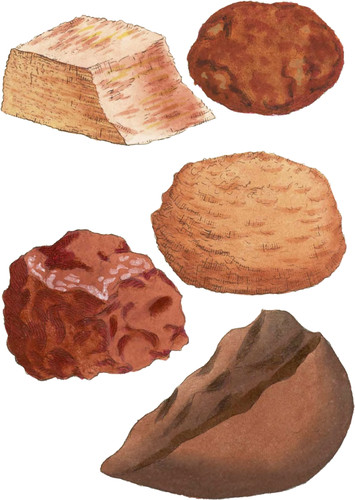 Enlarge
Enlarge
British Mineralogy
Ochre
- Syn.
- Colorific Earth. Kirw. 1. 194.
- Yellow Earth. Ditto.
- Gelberde. Werner.
The Red Ochres* often nearly the same in appearance with the Yellow ones when burnt, are occasionally found, and I have some even mixed with Yellow Ochre from Cornwall.
The upper right hand figure is perhaps a Steatitic Clay; Ruddle has more Iron in it. This and Venetian Red are nearly alike, both depending on a mixture, as it were, with Red Haematites—see tab. 56—or little else than Red Oxide of Iron. Both are found, or may be readily manufactured. The latter is a cheap and useful water colour, and the first answers many purposes; such as for a coarse oil paint for floor-cloths, or mixed with tar for paling, marking cattle, &c. It is of an earthy texture, rather loose, and is light and bright about the powdery part of the specimen.
The left hand upper figure is found colouring imperfect Schist in the Isle of Man, and was sent me by order of the Duke of Athol.
The lower specimen is of a looser texture from Devonshire, by favour of the Rev. A, Neck.
The deep red specimen annexed came from the Basaltic Rocks near Belfast. It is there often much indurated, and passes into a quartzose or flinty substance, forming Eisenkiesel of the Germans.
The lower fragment is from the Isle of Wight, and would nearly agree with Eisen-thon, or Iron Clay of the Germans, Its colour may denote it an Umber; it has, however, a reddish cast. It leads pretty well to the next variety, tab. 256.
- * Ochres, strictly speaking, perhaps ought only to be yellow, or yellowish. Common language, however, warrants the use of the words Red Ochre, as a name for this substance.

